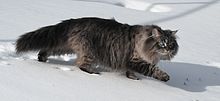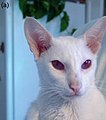Point cat

Point cats are cats whose body fur is lightened, while the cooler regions, the so-called points, such as the face, ears, legs, tail and scrotum are darker in color. The color of the points depends on the genetic basic color of the cat.
root cause
The cause of the discoloration of the body fur is a mutation which leads to partial albinism , due to the deficient function of the enzyme tyrosinase , which is necessary for the production of the pigment melanin . A hereditary metabolic disorder is responsible for the point coloring. In this form of albinism with temperature-sensitive residual activity, the tyrosinase is already inoperable due to normal body temperature, so only the cooler parts of the body such as extremities, tail, ears and nose gradually turn dark, while the fur near the warmer core remains lighter ( acromelanism ). Point cats are animals with albinism, but their melanin production is not completely switched off (see also genetic background). In cat breeding, this is known colloquially as the so-called coloration gene, also called the point gene, point factor. Point cats are born almost white because the uterus is so warm that melanin cannot be formed. In the course of the first weeks of life in the cooler air, the points then form and the fur darkens. This darkening process continues throughout life and then also extends to the body fur. Old point cats can therefore be quite dark, but remain recognizable as point cats. That the discoloration actually has something to do with the outside temperature is also shown by the fact that point cats that are kept in warm countries darken less than those that live in cooler surroundings. If a paw is partially shaved, e.g. B. for a blood sample, and then put under a bandage, the hair on the dark paw in the shaved area grows back light, because the temperature is increased under the bandage.
Other effects of partial albinism
The poor melanin production also affects the pigments in the iris and other structures of the eye. This primarily applies to cats with the Siamese factor (see: Genetic Variants). These cats always have blue eyes. Strabismus , strabismus, and nystagmus , eye tremors are very common in all point cats, but, unlike normal colored cats, do not represent an independent hereditary disease with their own inheritance, but are further effects of albinism: oculocutaneous albinism type 1 . It should be emphasized that, unlike in full-colored animals, in which nystagmus is primarily observed as a symptom of a neurological disorder and brain damage, nystagmus in point cats has nothing to do with such diseases. Point cats with nystagmus or strabismus are otherwise healthy. Because of the causal relationship between the desired point coloring and undesirable visual defects, there are limits to what can be influenced by breeding. The partial albinism of the Point cats is mentioned in the expert opinion on the interpretation of Section 11 b of the Animal Welfare Act . Since melanin is also involved in the formation of the reflective layer typical of cats in the fundus, this reflective layer ( Tapetum Lucidum ) is less reflective in point cats, which affects night vision. Although point cats often have problems restraint and likely have impaired binocular vision, this does not significantly affect their ability to hunt. It can only be observed that the preferred hunting times shift from night to early twilight. The two cats in the example photo above on the right also show a slight inward squint.
Genetic variants
In cats there are two genetically different variants, denoted by c s or c b . c s stands for Siamese factor , c b for Burma factor . One of the few intermediate heredities in the color genetics of cats (c s c b ) provides another variant, the Tonkanese . In common parlance, however, the point factor is usually equated with the Siam factor.
Cats that are purebred on the c s gene (Siamese and their descendants) always have blue eyes. On the other hand, cats that are pure-bred on the c b gene (Burmese and their descendants) have yellow eyes. Point cats, which have the intermediate inheritance c b c s (Tonkanese and their descendants), have green-blue to blue-green eyes. This color (c b c s ) also occurs in the Bengal breed ; it is called seal mink there.
Races
Well-known breed examples with the Siam factor are the already mentioned Siamese (short-haired), Holy Birman (half- long-haired) and Persian colorpoint (long-haired), Ragdoll cats and the Neva Masquerade as a color variant of the Siberian cat . Burmese cats (Burma factor) and Tonkanese as hybrid forms are less known to us. The so-called Snowbengals are also genetically point cats.
Point colors
In principle, every coat color can also occur as a point color, both the different variants of black and red and their dilution blue and cream, as well as the variants chocolate and cinnamon together with their dilution lilac and fawn. Even gold and silver are possible. Not all color variations are allowed for every breed. The classic Siamese color is called Seal-Point and is derived from black. Flame point is derived from red, sometimes also called red point. The other colors combine the name of the color with the word Point (e.g. Chocolate Point or Blue Point). Point cats can be solid color or have tabby patterns; in the US , tabby point cats are known as lynx points. White spotting is undesirable in many breeds with point markings and is excluded from the standard. With the Siamese cat, the "Siam with white" bears the name Seychellois. In the case of other breeds, such as the Neva Masquarade, there are no stipulations in the standard for the white proportion. In any case, many judges do not like it when a high proportion of white destroys the points. With the Holy Burma, on the other hand, white gloves, precisely defined in size and shape, are part of the breed standard. With the Ragdoll, too, a fixed proportion of white in terms of size and distribution is standard.
Blue Point Neva Masquarade
Ragdoll cat : Sealpoint with white spots
Siamese cat , lilac point (spots brown, lightened by dilute gene )
Siamese cat , Chocolate-Point (spots brown)
Genetic background
A form of albinism belonging to the subgroup OCA 1B is responsible for the development of point staining. OCA 1B is based on mutations in the tyrosinase gene, which causes an enzyme defect with residual tyrosinase activity. The production of pigment is not completely blocked, but some pigment can be formed by the residual function. More precisely, we are dealing with the subgroup OCA 1B TS = temperature-sensitive OCA 1B for the point staining of cats. The activity of the enzyme tyrosynase, which is necessary for melanin synthesis, is temperature-dependent.
There are comparable mutations in humans, in cattle ( White Park Cattle ) and in many rodents. 1 The mutation is inherited recessively. This means that both parents must be carriers of the mutation for the mutation to take effect. Point cats are therefore always pure breeding for the mutation and therefore only have point-colored offspring. If both parents are only carriers, point cats, normal-colored carriers and animals free from this mutation occur in the offspring in a ratio of 25% to 50% to 25%.
Chinchilla with color point drawing
Burmese cat with basic color black and the allele c b
swell
- Krista Siebel: Analysis of genetic variants of loci for coat color and their relationship to color phenotype and quantitative performance characteristics in pigs. Inaugural dissertation at the Institute for Livestock Sciences at the Humboldt University in Berlin, 2001.
- B. Käsmann-Kellner, B. Seitz: Phenotype of the visual system in oculocutaneous and ocular albinism. ISSN 0941-293X
- B. Käsmann-Kellner: children's ophthalmology, orthoptics, paed. Low vision. Campus, University Eye Clinic, Building 22, Homburg (Saar) Albinism, far more than just blue eyes
- RE Kalil et al .: Anomalous retinal pathways in the Siamese cat: an inadequate substrate for normal binocular vision. In: Science. 174, 1971, pp. 302-305.
for further sources see coat colors of the cat
Web links
- Käsmann-Keller: Phenotype of the visual system in oculocutaneous and ocular albinism. (PDF; 1.0 MB)
- Jon H. Kaas: Serendipity and the Siamese Cat: The Discovery That Genes for Coat and Eye Pigment Affect the Brain. (PDF; 119 kB)
- Donnell Creel, Anita E. Hendrickson, Audie G. Leventhals: RETINAL PROJECTIONS IN TYROSINASE-NEGATIVE ALBINO CATS. (PDF; 1.6 MB)
- Expert opinion on the interpretation of Section 11b of the Animal Welfare Act (prohibition of torture breeding)













